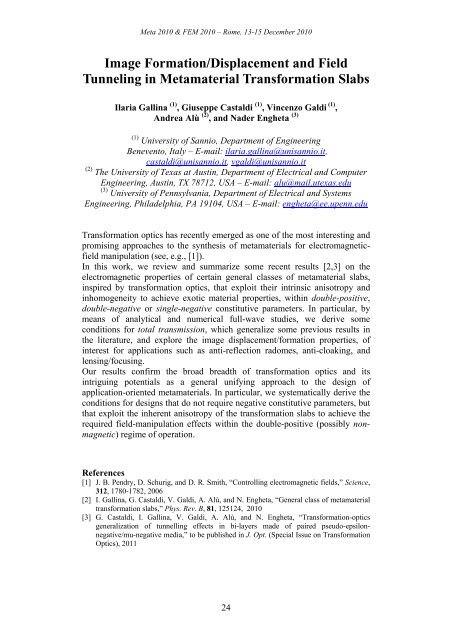Abstracts - Dipartimento di Elettronica Applicata
Abstracts - Dipartimento di Elettronica Applicata
Abstracts - Dipartimento di Elettronica Applicata
Create successful ePaper yourself
Turn your PDF publications into a flip-book with our unique Google optimized e-Paper software.
Meta 2010 & FEM 2010 – Rome, 13-15 December 2010<br />
Image Formation/Displacement and Field<br />
Tunneling in Metamaterial Transformation Slabs<br />
Ilaria Gallina (1) , Giuseppe Castal<strong>di</strong> (1) , Vincenzo Gal<strong>di</strong> (1) ,<br />
Andrea Alù (2) , and Nader Engheta (3)<br />
(1) University of Sannio, Department of Engineering<br />
Benevento, Italy – E-mail: ilaria.gallina@unisannio.it,<br />
castal<strong>di</strong>@unisannio.it, vgal<strong>di</strong>@unisannio.it<br />
(2) The University of Texas at Austin, Department of Electrical and Computer<br />
Engineering, Austin, TX 78712, USA – E-mail: alu@mail.utexas.edu<br />
(3) University of Pennsylvania, Department of Electrical and Systems<br />
Engineering, Philadelphia, PA 19104, USA – E-mail: engheta@ee.upenn.edu<br />
Transformation optics has recently emerged as one of the most interesting and<br />
promising approaches to the synthesis of metamaterials for electromagneticfield<br />
manipulation (see, e.g., [1]).<br />
In this work, we review and summarize some recent results [2,3] on the<br />
electromagnetic properties of certain general classes of metamaterial slabs,<br />
inspired by transformation optics, that exploit their intrinsic anisotropy and<br />
inhomogeneity to achieve exotic material properties, within double-positive,<br />
double-negative or single-negative constitutive parameters. In particular, by<br />
means of analytical and numerical full-wave stu<strong>di</strong>es, we derive some<br />
con<strong>di</strong>tions for total transmission, which generalize some previous results in<br />
the literature, and explore the image <strong>di</strong>splacement/formation properties, of<br />
interest for applications such as anti-reflection radomes, anti-cloaking, and<br />
lensing/focusing.<br />
Our results confirm the broad breadth of transformation optics and its<br />
intriguing potentials as a general unifying approach to the design of<br />
application-oriented metamaterials. In particular, we systematically derive the<br />
con<strong>di</strong>tions for designs that do not require negative constitutive parameters, but<br />
that exploit the inherent anisotropy of the transformation slabs to achieve the<br />
required field-manipulation effects within the double-positive (possibly nonmagnetic)<br />
regime of operation.<br />
References<br />
[1] J. B. Pendry, D. Schurig, and D. R. Smith, “Controlling electromagnetic fields,” Science,<br />
312, 1780-1782, 2006<br />
[2] I. Gallina, G. Castal<strong>di</strong>, V. Gal<strong>di</strong>, A. Alù, and N. Engheta, “General class of metamaterial<br />
transformation slabs,” Phys. Rev. B, 81, 125124, 2010<br />
[3] G. Castal<strong>di</strong>, I. Gallina, V. Gal<strong>di</strong>, A. Alù, and N. Engheta, “Transformation-optics<br />
generalization of tunnelling effects in bi-layers made of paired pseudo-epsilonnegative/mu-negative<br />
me<strong>di</strong>a,” to be published in J. Opt. (Special Issue on Transformation<br />
Optics), 2011<br />
24








